Your site’s content exists for one purpose: to attract, delight, and engage your target audience.
As obvious as that statement sounds, it is surprisingly easy to lose sight of the centrality of your audience when deciding what content to create for your site.
All too typically the content ideation process is limited to things like internal brainstorming, keyword research, things we think are important about our business or service, or pure guesswork.
As useful as those approaches can be, they can all still miss the mark of knowing what your audience actually cares about.
Discovering what your audience cares about that is relevant to your business involves three understandings:
- Understanding how people search for things relevant to you.
- Understanding why people search for things relevant to you (intent).
- Understanding what people want to know about things relevant to you.
Having all three of these in mind is essential to knowing exactly what kinds of content you need to produce for your audience.
Let’s look more deeply into each of those understandings and how you would research them.
1. Understanding How People Search
Most experienced SEO professionals advise starting the process of determining what content your site needs by doing keyword research.
To learn how to do that correctly, see my guide, How to Do Keyword Research for SEO, here on Search Engine Journal.
Good keyword research is essential, but it is only the beginning.
One of the limitations of initial keyword research is it only uncovers the most common terms and phrases used to search for topics important to your business.
In reality, however, people use all sorts of different words to search for something.
In order to understand and cover all the ways people are searching for your products, services, and related topics, you need to know the semantically-related terms for your topics and keywords.
What Is Semantic Relationship?
Remember the popular Kevin Bacon meme?
The meme was based on the supposition that everyone in the world is no more than six degrees of separation from actor Kevin Bacon.
Meaning that the chain of real-world relationships that could connect you with Bacon never extends farther than six levels.
Words also have relationships.
The semantic relationship between any two words or phrases is evaluated by their degree of separation in common usage.
In other words, the more frequently people use the words in conjunction with each other, in talking about the same or similar things, the closer their semantic relationship.
By analyzing huge samplings of human language (such as queries entered into a search engine) we can determine the “degree of separation” between terms and phrases.
The closer they are to each other, the stronger the semantic relationship, and the higher their priority for consideration in your content plans.
Using Semantic Relationships
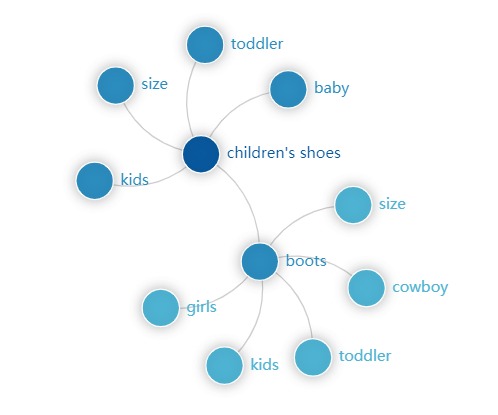 Semantic nodes for “children’s shoes”
Semantic nodes for “children’s shoes”Above is a graph of the closest semantic nodes for “children’s shoes” in Google searches.
We can see that people who are interested in children’s shoes may also be interested in more specific categories such as “boots” and then even more specifically, things like “children’s boot sizes” or “children’s cowboy boots.”
Semantic relationship research is so important to covering the universe of closely-related topics around your main topics that you should make sure whatever keyword research tools you investigate include some kind of semantic search capability.
However, sometimes important semantic relationships are even closer than one degree of separation.
An example of this is the term “conjunctivitis.”
Though that is the technically correct term for a certain eye condition, the vast majority of regular searchers will search for its colloquial equivalent, “pink eye.”
Understanding and researching semantic relationships can help you better cover your important topics with content geared to the way real people actually search.
2. Understanding Why People Search
The second important understanding for better SEO content creation centers around the search intent of users.
Search intent has to do with what people actually want to accomplish with their search.
Most of the time people aren’t searching randomly; they have some purpose, some goal they are trying to accomplish.
There are different ways to categorize search intent, but the four most common are:
- Informational: The user wants to fill in a knowledge gap about the topic.
- Examples: “Who was Abraham Lincoln?”, “How to repair a zipper.”
- Navigational: The user is trying to find a specific source or site.
- Examples: “facebook,” “Nordstrom,” “youtube.”
- Transactional: The user wants to purchase something.
- Examples: “hotels in Minneapolis,” “DSLR cameras cheap.”
- Local: The user is looking for something in their local area.
- Examples: “Asian fusion restaurants nearby,” “shipping services near me.”
In recent years Google has been getting better at sniffing out the search intent of its users.
We know this because when a new search term appears that seems ambiguous at first, we’ll often see Google at first present results on page one that are for various intents.
Then over time, as Google sees what people click on, the result tends to favor one intent over the others.
So it follows that it’s not enough to create content for how searchers are searching for your topics (i.e., the words they are using), but also for why they are searching.
In other words, your content has a better chance of ranking if it matches well with the intent search engines think most people have when using your keywords.
How to Discover Search Intent
Because Google has become increasingly adept at sniffing out the most common search intent for a given query, one of the best ways to discover that intent is to enter your keyword in Google and look at the SERP.
Does it have SERP features like Featured Snippets and People Also Ask?
Do the top organic web results seem to be answering a question or giving basic facts about the topic?
Then the search intent is probably informational.
Are there a lot of PPC ads on the page, or are the top organic web results mostly ecommerce sites (or sites selling a service)?
Then the search intent is probably transactional.
Does it have map results, local listings, or are the top organic web results primarily businesses or entities near you?
Then the search intent is probably local.
There is also a limited selection of tools that will supply search intent for keywords, usually based on machine-learning analysis of search results and sometimes even the content they link to.
How to Use Search Intent
Let’s say your keyword is “women’s clothing.”
Enter that in Google and look at the first page of results.
Leading off are four PPC ads and some Google Product Ads off to the side:
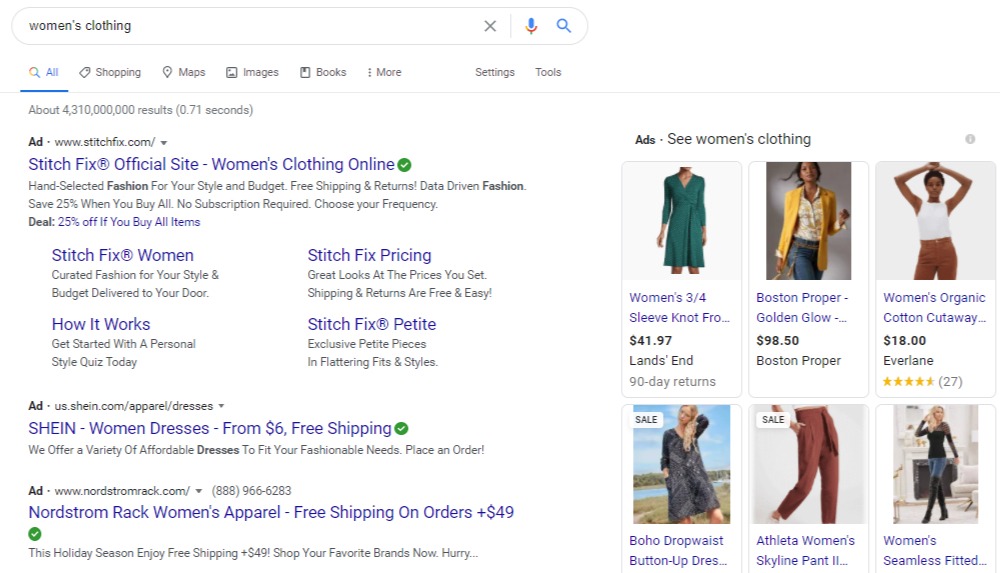
Immediately after the ads is a local map result with three stores near me:
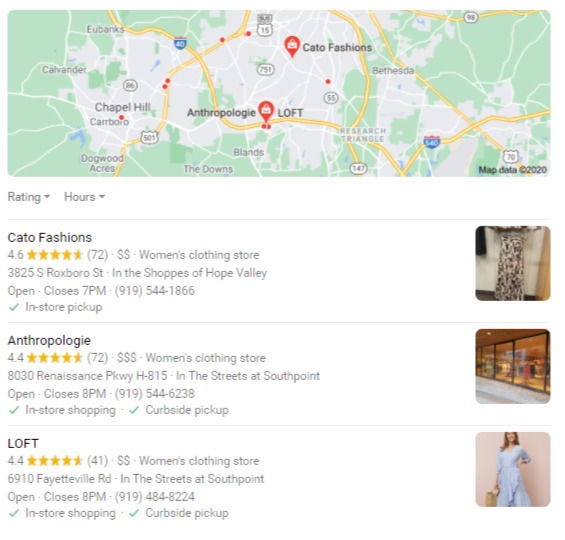
And then we come to the organic web results, which are all ecommerce sites of major brands.
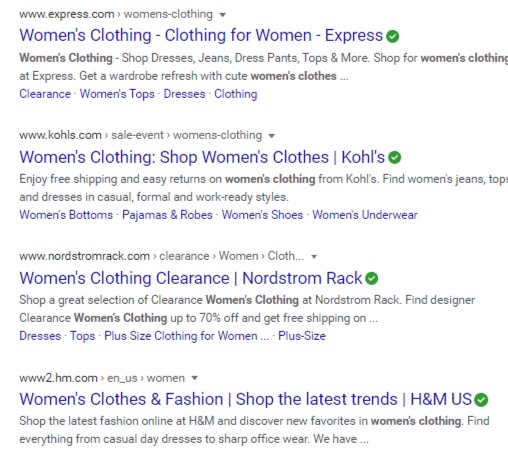
Admittedly there is some mixture of intent here, as Google included a local map results box, but the majority of the page is taken up by purely transactional results.
Therefore, if you were targeting the keyword “women’s clothing,” you’d want to make sure you had a well-optimized landing page with women’s clothing for sale.
Now search for “how to buy women’s clothing” and see how the first page of Google changes.
Now we see only one ad and a smaller products carousel, followed by a Quora page answering the question “how to buy women’s clothing” and a People Also Ask box.
The primary search intent for this query seems to be informational.
So you’d want to have content that answers the question, such as a guide to selecting women’s clothing.
3. Understanding What People Want to Know
As important as it is to know what people enter when they search for things relevant to your business and what their intent is, it is equally important to have a handle on the actual information that will be useful to them.
In other words, what do they really need to know?
What content will scratch the itch and satisfy them in ways that leave them favorably inclined toward your brand?
Beyond that, it’s also important to know (and cover) related things people want to know.
People who enter one question in search often really have a list of related questions they also want to know about.
Power of People Also Ask
We can be thankful that Google actually does a lot of that research for us and puts it right into the SERPs for free!
I’m talking about the People Also Ask feature that shows for so many informational and transactional searches these days.
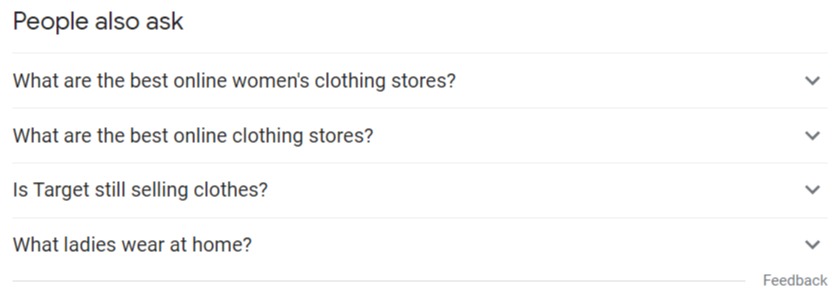
People Also Ask is semantic search data on steroids, giving you actual queries people commonly make related closely to your topic.
If you build content using suggestions from People Also Ask you not only can rank for a broader range of queries, you also likely improve Google’s impression of your site as an authority on the topic.
Reaping From Ranking Content
Another way you can dig deep into what people want to know about your topic is by clicking through the top organic web results for your keyword.
Examine the top-ranking content.
What does it cover, what elements does it have, what questions does it answer that your content does not cover?
A large part of the reason that content is ranking is because Google deems it to be the most thorough and useful answer to the query.
So you want to make sure your content covers all the same bases, and then goes even further to be more worthy than the ranking content.
Topping Off from Top Stories
While it won’t show up for every query, Google’s Top Stories feature can also be a source of straight-from-the-SERPs information on what matters to your target audience.
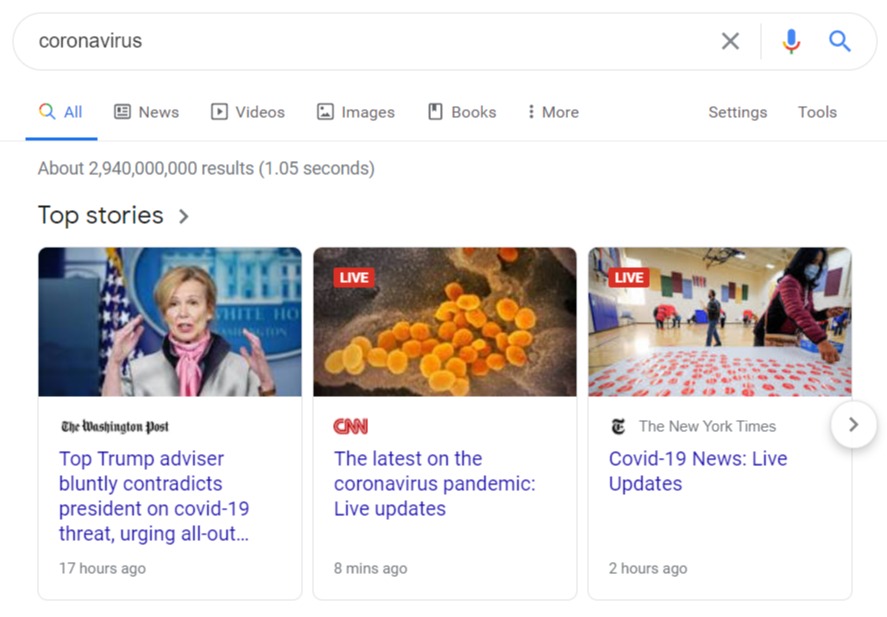
Top Stories draws from publishers and news sources to provide searchers with the most current information on a topic.
Taking the time to read some of that content, and perhaps revisit it from time to time for updates, can help you add freshness to some of your content that lets Google know you also are up-t0-date.
How, Why & What: Bringing It All Together
The type of content with the best chance of connecting with your audience (and thereby being attractive to search engines) incorporates research from all three of these aspects:
- How people search (the words they use).
- Why people search (what their intent is).
- What people want to know (the specific content that will satisfy them).
If you are able to answer all three of these aspects for your most important topics, you will be well on your way to creating content that will not only get you better search rankings, but earn you the attention you crave from your audiences.
More Resources:
- How to Create Perfectly Optimized Content: 16 Essential Elements
- 7 Methods to Research & Analyze Your Audience for SEO
- SEO for Beginners: An Introduction to SEO Basics
Image Credits
All screenshots taken by the author, November 2020





